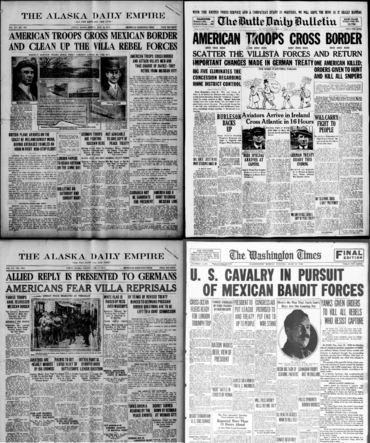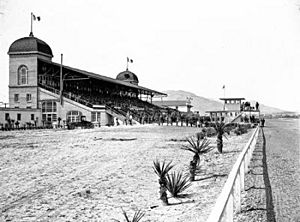Battle of Ciudad Juárez (1919) facts for kids
Quick facts for kids Third Battle of Ciudad Juarez |
||||||||
|---|---|---|---|---|---|---|---|---|
| Part of the Mexican Revolution, Border War | ||||||||
 News Coverage of the Battle of Ciudad Juárez |
||||||||
|
||||||||
| Belligerents | ||||||||
|
|
|||||||
| Commanders and leaders | ||||||||
| Strength | ||||||||
| 9,500 revolutionary Pancho Villa | 7,300 Mexican soldiers | 8,600 American soldiers | ||||||
| Casualties and losses | ||||||||
| ~150 killed or wounded | 67 Mexican soldiers and 27 civilians killed | 2 killed 10 wounded |
||||||
|
|
||||||||
The Third Battle of Ciudad Juarez, also called the Battle of Juarez, was a big fight involving the rebel leader Pancho Villa and his army. It happened on June 15, 1919. Villa tried to take control of Ciudad Juarez, a city on the border with the United States.
During the battle, Villa's soldiers accidentally caused the United States Army to get involved. The US Army was protecting the nearby city of El Paso, Texas. The American soldiers quickly defeated Villa's army. This battle was the second largest fight in the Mexican Revolution that involved the US. It was also the last battle of the Border War.
With the American army coming closer, Villa's soldiers had to leave. Pancho Villa then tried to attack Durango but lost again. After that, he went back to his home in Parral, Chihuahua, in 1920. The Mexican government at the time, led by the Carrancistas, gave him a full pardon, meaning he wouldn't be punished.
Why the Battle Happened
Pancho Villa's Army After 1917
After some earlier battles in 1916 and 1917, Pancho Villa's army was spread out. But by 1918, he had gathered several hundred men again. They started attacking the Carrancistas, who were the government forces in Mexico.
Villa's army didn't have much success in their last campaigns. They captured some smaller towns but avoided the city of Chihuahua. It had too many government soldiers. Instead, Villa decided to attack Ciudad Juarez in the summer of 1919.
Why Attack Ciudad Juarez?
Historians aren't completely sure why Villa chose Juarez. One idea is that Villa wanted his general, Felipe Ángeles, to lead the attack. Ángeles had talked about making peace with the Americans. Villa might have hoped this would change the US attitude towards his rebels.
Another reason could be that Juarez had fewer enemy soldiers than Chihuahua. There was also a good supply of food there. Villa might also have wanted to see if the Americans, just across the Rio Grande river, were still against him.
The new Carrancista commander in the area, General Juan Agustin Castro, was also a factor. He wasn't as aggressive as the previous commander. Castro preferred to stay in a few towns and not attack. This made Villa feel more confident that he could win in Juarez without being attacked from behind.
Forces Involved
Pancho Villa's army had over 4,000 infantry (foot soldiers) and cavalry (soldiers on horseback). But they had no artillery (large guns like cannons).
The Carrancista forces were led by General Pablo González Garza. They had nearly 3,000 soldiers. They had made Juarez stronger and were holding a fort called Fort Hidalgo. General Gonzalez also had artillery. He had two other important advantages: he was fighting a defensive battle, and he was protected by El Paso and the American army to the north.
The Battle Begins
Villa's Attack on Fort Hidalgo
Pancho Villa and his army arrived at Ciudad Juarez on the night of June 14, 1919. They first attacked Fort Hidalgo at 12:10 AM on June 15. But after about 50 minutes, they were pushed back.
General Martin Lopez, who was Villa's close friend, led this attack because Villa was sick. Around 1:10 AM, Lopez attacked the city itself. The cavalry rode ahead of the foot soldiers. They were careful not to shoot bullets across the border into El Paso.
Fighting in the City
At first, Villa's soldiers seemed to be winning. They used wire cutters to get through barbed wire fences. They also pushed back a line of Carrancista foot soldiers. But as Lopez moved deeper into the city streets, their advance slowed down.
For the rest of the morning and all day, the two sides fought very closely. General Gonzalez, the Carrancista commander, was watching the battle from the rooftop of the Municipal Palace. As his soldiers started to lose ground, his assistant told him that Villa's men were "attacking like rabid dogs."
Gonzalez was advised to move his soldiers into the nearby fort, or they would be defeated. He agreed and ordered a retreat. Villa's soldiers then took full control of the city. Once Gonzalez reached the fort, he used the telephone to ask the American army across the river for help. The Americans had already started getting their soldiers ready, but they hadn't received orders to act yet.
American Involvement
Villa knew his only chance to take the fort was to use some captured Carrancista cannons. General Angeles was supposed to move these cannons from Juarez to the fort. This took some time.
While they were doing this, General Gonzalez came up with a bold plan. He used most of his cavalry and infantry to charge at Angeles's group as they got close to the fort. This charge worked, and Angeles's men ran back to Juarez. But Villa's soldiers still held the downtown area.
Meanwhile, on the Texas side of the border, American soldiers were being shot at by Villa's snipers. These snipers were aiming at the American artillery headquarters. Several American soldiers were hurt, but they didn't shoot back. Also, two American civilians were killed and four were wounded.
The US government later investigated and believed Villa's soldiers were responsible for these civilian deaths. The Americans, led by Brig. Gen. James Brailsford Erwin, didn't respond until 10:35 PM. At that time, an American soldier was killed and another was badly wounded.
Around 11:00 PM, after learning about the casualties, General Erwin sent 3,600 American soldiers across the Santa Fe Street bridge. Their goal was to stop the shooting and protect American citizens.
American Counterattack
General Erwin's forces included two groups of African American soldiers from the 24th Infantry. They also had artillery and cavalry units. Heavy fighting began, and the Carrancista soldiers went back to their fort. This left only the Americans and Villa's soldiers fighting.
The 24th Infantry crossed the bridge and moved through the center of Ciudad Juarez. The American artillery supported them from downtown El Paso. The cavalry units crossed the Rio Grande further downstream. They tried to surround Villa's soldiers.
At 12:30 AM on June 16, the American artillery in El Paso started firing. They aimed at the Juarez Racetrack, where Villa's forces were. They kept firing until 1:00 AM. In that time, they fired 64 shrapnel rounds.
By 4:00 AM, the Americans reached a building in Juarez. Villa's soldiers were retreating. The American cavalry, led by Colonel Selah "Tommy" Tompkins, and some artillery units chased the rebels south.
Around 7:00 AM, six miles southeast of Juarez, the Americans found a large group of Villa's soldiers. The cavalry immediately charged. The artillery fired from about 4,000 yards away. The first shot was a direct hit. Shrapnel rounds completely wiped out one part of Villa's force. The other two parts scattered in different directions. This fight was over by 9:00 AM. Later that day, as the Americans continued their chase, they found about 25 dead or wounded Villistas after bombarding a small building.
After the Battle
Villa's Retreat and Losses
When the chase finally stopped, Colonel Tompkins headed back north. He collected 50 saddles, 300 horses and mules, and over 100 rifles left behind by Villa's soldiers. Many of the guns were German-made, and soldiers took them as souvenirs.
Two American soldiers were killed and ten were wounded during the fighting, including those hurt before the US officially joined. The number of Carrancista casualties is unknown. The Americans reported that they killed or wounded at least 100 of Villa's soldiers, including General Lopez. However, the true number of casualties was probably much higher.
Pancho Villa later gave an interview. He said he ordered his soldiers to leave Ciudad Juarez because the American bombing was hurting many civilians. He also felt it was pointless to fight an enemy that had more soldiers and better equipment. Villa claimed many of his best officers and hundreds of his ordinary soldiers were lost.
However, Villa's statement has been questioned. The American artillery only focused on the racetrack, which was Villa's base. Also, many of his men left the army after the battle, rather than being ordered to scatter.
Villa's Final Campaigns
Just a few weeks later, Villa tried to attack Durango. But he only had about 350 soldiers left, and they were not in good spirits. The attack failed when the Carrancistas launched a surprise attack from behind, forcing Villa to retreat again.
The siege of Durango was Pancho Villa's last major battle. After that, he led the rest of his army into the Sierra Madre mountains. He even used a new "Aerial Corps" with planes to watch enemy movements and bomb their convoys.
Villa was very angry about the American soldiers getting involved in the Battle of Juarez. He reportedly told his men they could kill any Americans they met in the future. He also warned Mexican people that if they worked with Americans, he would return and kill them. However, there is no proof that Villa's men killed any Americans after the Battle of Juarez.
Villa's Retirement and Death
By August 1920, Pancho Villa had had enough. He surrendered to the Carrancista government. He was given a full pardon and retired to a large ranch in Durango. He had a bodyguard of 50 men.
Three years later, on July 16, 1923, Pancho Villa was killed while visiting the city of Parral. The people who killed him were most likely agents sent by Alvaro Obregon. Obregon had become president after ordering the death of another leader in 1920.
A National Guard camp was later named Camp Tusco, after the American soldier killed in the battle. The 82nd Field Artillery's unit symbol shows a black artillery shell on a white background. This represents the first shot fired by the regiment over the Rio Grande.
Images for kids




